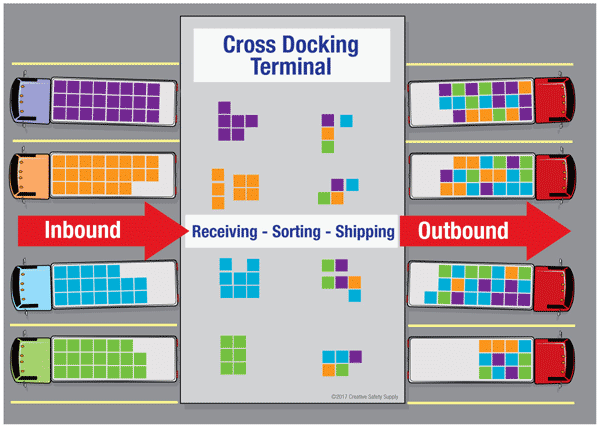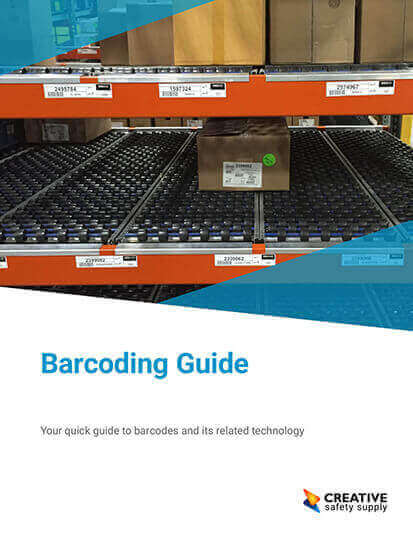
Companies work to maximise procedures and enhance supply-chain management operations by adopting strategies. One of them is cross-docking. Industrial sectors like warehouses, manufacturing facilities, and sectors responsible for exporting goods or products benefit from this approach. If you’re unfamiliar with cross-docking, this article can help you get up to speed.
What Is Cross-Docking?
Cross-docking is a logistical strategy where products and materials are unloaded from one inbound source (truck, railcar, etc.) and then immediately moved onto outbound transportation with as little storage time as possible. This is desirable because the longer products sit in a warehouse or other storage location, the less overall value they provide.
How Cross-Docking Works
Cross-docking follows a straightforward process, which is segregated into simple steps:
Inbound delivery: Goods are received at the distribution center, usually a warehouse or a storage facility. The good are stored there for a minimal amount of time.
Sorting process: The products are stored and cross-checked again to ensure they are heading in the right direction. This process includes checking the order number, address, and the handler's information.
Outbound transfer: The sorted products are directly unloaded into waiting trucks, which will transfer them to their final destination. This is the highlight of the cross-docking process and requires attention to detail and care from the handlers.
This cross-docking process aims to minimize inventory storage, where the risk of loss and damage of resources is high. By adopting this process, companies and warehouses can streamline their supply chain management process.
Categories Of Cross Docking
To speed delivery times, companies refer to cross-docking as part of their supply chain management strategy It can be categorized into two different sub-sections:
Pre-distribution cross-docking: Based on this approach, a product supplier identifies the final customer or destination for each product. Once the products are categorized based on their destination, they are sorted as such in the cross-docking facility. This helps reduce storage space and alerts manufacturers on product availability.
Post-distribution Cross-Docking: Unlike its counterpart, this strategy focuses on after the products have arrived at the facility. The goods are stored firsthand and then their destination is determined, followed by unloading them to outgoing trucks. The benefit of this approach is that it provides suppliers more time to determine the product shipment based on demand and shortage.
Types Of Cross Docking
There are several types of cross-docking, each designed to meet unique needs.
Continuous Cross Docking
Continuous flow of products from a cross-docking facility is known as continuous cross-docking. This strategy requires little to no time, as the process is always in motion. As such, the products are unloaded from incoming trucks, and instead of loading them onto a storage unit or facility, they are taken to outbound trucks or containers. There is no stop or interruption of movement within this type.
The motive is to move the products as quickly as possible, which requires precision, synchronization, and a high level of collaboration among suppliers. This format is utilized when there is a large shipment of products that needs to be urgently delivered with no lead time.
Consolidation Cross-Docking
Consolidation cross-docking involves combining multiple, smaller product shipments from various incoming trucks or containers to create a single, large outbound shipment. The objective of this type is to reduce shipping costs, as there’s a substantial cost on one truckload compared to multiple smaller loads.
Unlike continuous, consolidation requires products first to reach the facility and collect till a certain limit until the company deems it sufficient to place a large outgoing truck.
Deconsolidation Cross-Docking
Opposite to its partner type, deconsolidation follows a reverse method to consolidation cross-docking. In this case, a large incoming load is collected at a cross-docking facility and then divided into smaller shipments for delivery to customers. This method is usually applied to large product shipments traveling from overseas. A large shipment is sent abroad and then divided into smaller loads for delivery to customers in another country. Retail stores are common examples of those who follow the deconsolidation method as they receive large shipments from suppliers and then divide them into smaller batches for delivery.
Where Is Cross-Docking Used?
Warehouses And Distribution:
Cross docking is most commonly used as part of a company's warehouse and distribution efforts. Many companies have products brought into a warehouse where they are sorted, consolidated, and then put onto another truck or transport vehicle to go out to a retail outlet. These locations serve as warehouses or distribution centers.
The distribution center can accept large deliveries of products, which are then broken up into groups to be sent out to each individual store that they operate. Major retailers such as Walmart are examples of this type of strategy.
Cross-docking helps simplify the warehousing and distribution of products for many companies. It involves a systematic approach where transportation trucks have all the suppliers bringing products to one central location. From there, the retailer receives the products, sorts them, and then ships them where they need to go. This gives the retailer much more control over which store is going to get which products.
Working with Third Party Logistic Companies
Cross-docking often uses third-party logistic companies to help implement and manage the system. These companies are experts at streamlining the receiving, sorting, and shipping of products from centralized distribution centers. Many companies use these logistic experts to get their system up and running and then take it over to handle for the long term.
Others simply contract the process out. Third-party logistic companies can have one distribution center that serves dozens of companies. All the products for each company are sent to this one center, and the logistics company organizes and distributes all these products. This is a very economical way to handle receiving and distribution, especially for small to mid-sized companies that may not need a full facility for themselves.
Cross-Docking Stations Within A Facility
Although primarily used to handle the incoming and outgoing parts, products, and other items for multiple locations, it is also possible to use cross docking stations to help improve efficiency within a single facility.
A cross-docking station can be a specific area within a facility where all parts, products, tools, and other required items are delivered. This station will then go through and sort everything so it is organized and ready to be used when needed. When a specific department within the facility needs something, the station will have it delivered directly to this area.

Advantages Of Cross-Docking
Control: Companies get to direct product levels at a much more detailed level. This ensures each retail outlet gets exactly what it needs to meet customer demands, no more and no less.
Just in Time: Often used for just-in-time manufacturing, where supplies are delivered where they are needed as they are needed to ensure there is no excess storage of parts or products.
Lower Warehousing Costs: With this type of distribution strategy in place, there is much less need for warehousing products, which saves companies money.
Enhanced Organization: When properly implemented, this strategy can help keep a company's supply line more organized.
- Reduced Labor Costs: With less storage and warehousing, there is less need for people handling the products, which can help drive down labor costs.
Using advanced machines that can read bar codes, QR codes, or RFID tags that are placed on incoming products and then sorting them automatically, for example, is a great way to automate much of the receiving and sorting process. Very advanced facilities, such as those run by UPS, have nearly 100% automation from the time packages are unloaded from one truck all the way through to the point where they are loaded onto an outgoing truck.
How To Build An Effective Cross-Docking Strategy
Any time a product is stored, it is considered as time that it is not creating value for the company or the customer.In addition, storage time introduces additional risk. The following are some key reasons why a company should avoid storing products:
Drop in Value: Products that are kept in storage can potentially drop in value due to changes in demand, aging issues, and more.
Change in Demand: Demand for most products changes over time and, in many cases, drops. Products in storage are at risk of becoming undesirable and, therefore, worth less.
Damage or Theft: Having products sitting on a shelf in a warehouse leaves them exposed to the risk of damage, theft, or other issues.
There are many other reasons why avoiding product storage as much as possible is a good idea. Eliminating waste and risk is important for any company and is the focus of strategies such as 5S.
Improve Facility Efficiency
This can be a very efficient way to keep a workplace more organized. In addition, it can help reduce excess inventory because the central area will track what is in the facility and what is being used. A facility can make adjustments to the ordering of inventory or other supplies to help minimize the amount they have on hand at any given time.
Another advantage of an internal cross docking station is that it can keep track of a lot of equipment and supplies to reduce the risk of theft or loss. If a department needs to use specific tools for a job, they will have it checked out, and the tool will be tracked until it is returned. This process can typically be automated as well to ensure each area has access to what they need when they need it.
Cross Dock Terminal
Having a designated cross-dock terminal can help enhance delivery speed times with optimal results. Supplies are brought into the receiving area, which is typically on one side of the station. This is also where any tools or reusable parts and equipment will be returned after use. On the other side of the station is where individuals or departments will pick up the items they need.
Use Of Workplace Organizational Tools
Using advanced machines that can read bar codes, QR codes, or RFID tags that are placed on incoming products and then sorting them automatically, for example, is a great way to automate much of the receiving and sorting process. Advanced facilities, such as those run by UPS, have nearly 100% automation from the time packages are unloaded from one truck all the way through to the point where they are loaded onto an outgoing truck.
Build A Successful Cross-Docking Operation With CSS
Every company has a different set of requirements, which require adjustments for efficiency. With the right planning, you can significantly improve efficiency in most companies. At Creative Safety Supply, we provide high-quality safety signs and tapes to ensure maximum productivity.
Whether you opt for continuous cross-docking or choose an alternative, we offer personalized safety signage to ensure proper workflow. Contact us to learn more about our safety signs, or use our resources and guide to streamline your operations.
Need barcodes?
Our free barcode generator allows you to create custom barcodes readable with any scanner.
Every company will have a different set of requirements, which will require adjustments to the implementation of cross docking. With the right planning up front, however, it is possible to see very significant improvements in efficiency in most companies.
Sources
Similar Articles
- Warehouse Management (Supply Chain Systems + Visual Management)
- Floor Marking Ideas for Warehouses
- Perpetual Inventory System
- Understanding the Principles of Lean Construction
- What is Logistics Management? (Supply Chain)
- Understanding the SIPOC Diagram in Six Sigma
- What is Lean Logistics?
- Understanding the NFPA 704 Diamond Labeling System
- Understanding The 5S Methodology Implementation
- 5 Lean Principles for Process Improvement


